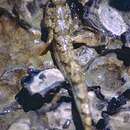Diagnostic Description
provided by Fishbase
Differs from P. argentilineatus by lacking thin silvery bars ventrally on the sides and having pelvic fins connected at the base by a low membrane (Ref. 37816); further characterized by: frenum of pelvic fins vestigial, but visible macroscopically; pelvic fins united by membrane for about one half their length; D1 height moderate, its margin rounded, black stripe inframarginally with numerous white spots proximally, no elongate spines; D2 with single dusky stripe inframarginally; dorsal fins not connected by membrane; D1 with 11-15 spines; longitudinal scale count 66-86; head width 16.5-22.5% SL; pelvic fin length 13.1-15.4% SL; length of anal fin base 15.9-18.7% SL; length ofD2 base 18.5-23.8% SL; total D2 elements 12-13; total analfin elements 11-12; TRDB 18-22 (Ref. 5218).
- Recorder
- Cristina V. Garilao
Morphology
provided by Fishbase
Dorsal spines (total): 8 - 16; Dorsal soft rays (total): 10 - 12; Analspines: 1; Analsoft rays: 9 - 11
- Recorder
- Cristina V. Garilao
Trophic Strategy
provided by Fishbase
Amphibious air-breather (Ref. 31184) that spends most of its time out of the water; able to meet its oxygen requirements as long as it stays wet. Typically resting on mud, rocks, or mangrove roots with their tails dipped in the water. Feeds on worms, crustaceans, and insects.
- Recorder
- Drina Sta. Iglesia
Biology
provided by Fishbase
Amphibious air-breather (Ref. 31184) that spends most of its time out of the water; able to meet its oxygen requirements as long as it stays wet. Typically resting on mud, rocks, or mangrove roots with their tails dipped in the water. Active at low tide and hunt in the intertidal zone for invertebrates; feeds on worms, crustaceans, and insects as well as polychaetes living on or near surface (Ref. 92840)
- Recorder
- Estelita Emily Capuli
Importance
provided by Fishbase
fisheries: of no interest
- Recorder
- Estelita Emily Capuli
Common mudskipper
provided by wikipedia EN
The common mudskipper (Periophthalmus kalolo) is a species of mudskipper native to marine and brackish waters of the Indo-Pacific from eastern Africa to Samoa. This species can be found in mangrove forests where it spends most of its time out of the water. This species can reach a length of 14.1 centimetres (5.6 in) SL.[1] The common mudskipper can deal with the chronic temperatures of up to 37°C and a chronic low of 14°C.[2] Larger individuals aggregate in exposed intertidal mudflats and tend to spend about 90% of their lifetime out of the water.
References

- license
- cc-by-sa-3.0
- copyright
- Wikipedia authors and editors
Common mudskipper: Brief Summary
provided by wikipedia EN
The common mudskipper (Periophthalmus kalolo) is a species of mudskipper native to marine and brackish waters of the Indo-Pacific from eastern Africa to Samoa. This species can be found in mangrove forests where it spends most of its time out of the water. This species can reach a length of 14.1 centimetres (5.6 in) SL. The common mudskipper can deal with the chronic temperatures of up to 37°C and a chronic low of 14°C. Larger individuals aggregate in exposed intertidal mudflats and tend to spend about 90% of their lifetime out of the water.
- license
- cc-by-sa-3.0
- copyright
- Wikipedia authors and editors
Description
provided by World Register of Marine Species
Amphibious species spending most of the time out of the water; able to meet its oxygen requirements as long as it stays wet. Typically resting on mud, rocks, or mangrove roots with their tails dipped in the water. Feeds on worms, crustaceans, and insects.
Froese, R. & D. Pauly (Editors). (2023). FishBase. World Wide Web electronic publication. version (02/2023).
- license
- cc-by-4.0
- copyright
- WoRMS Editorial Board

